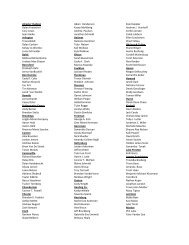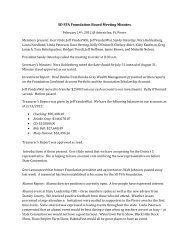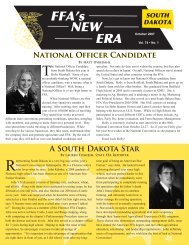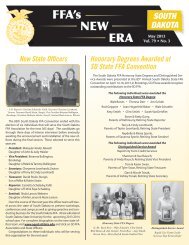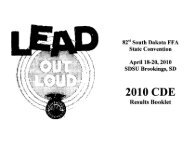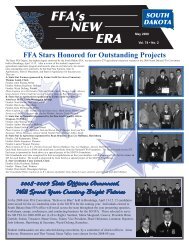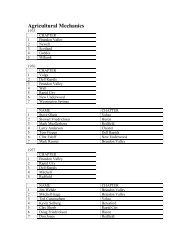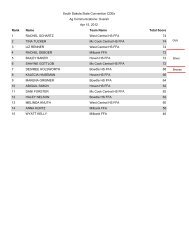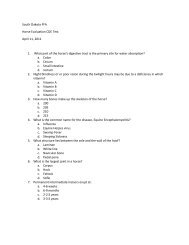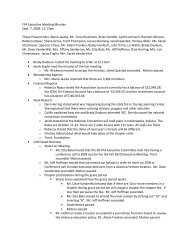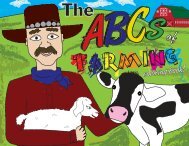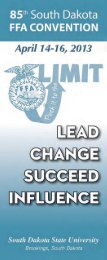Nursery/Landscape - South Dakota Team Ag-Ed
Nursery/Landscape - South Dakota Team Ag-Ed
Nursery/Landscape - South Dakota Team Ag-Ed
You also want an ePaper? Increase the reach of your titles
YUMPU automatically turns print PDFs into web optimized ePapers that Google loves.
Revised January 2013<br />
<strong>South</strong> <strong>Dakota</strong> FFA <strong>Nursery</strong> and <strong>Landscape</strong> Career Development Event<br />
A Special Project of the <strong>South</strong> <strong>Dakota</strong> FFA Foundation<br />
Important Note: Please thoroughly read the General Rules at the beginning of this handbook for complete rules and<br />
procedures that are relevant to all <strong>South</strong> <strong>Dakota</strong> FFA Career Development Events.<br />
I. Purpose<br />
The purpose of the <strong>Nursery</strong> and <strong>Landscape</strong> Career Development Event is to promote career<br />
interest, encourage proficiency development, and recognize excellence in individuals<br />
through this event which includes all aspects of the nursery and landscape industry.<br />
II. Objectives<br />
A. To apply nursery and landscape principles and practices as they impact residential,<br />
commercial, public, and recreational applications.<br />
B. To demonstrate the ability to identify, select, and utilize nursery and landscape plants<br />
(interior/exterior), landscape materials, and turf grasses commonly used in the United<br />
States.<br />
C. To demonstrate the ability to identify unhealthy plant conditions due to pests,<br />
nutritional/physiological disorders and mechanical/chemical injury.<br />
D. To demonstrate knowledge of the principles and skills involved in propagation, growth<br />
requirements, growing techniques, harvesting, sustainability, marketing, and<br />
maintenance of interior and exterior landscape plants and turf grasses.<br />
E. To demonstrate knowledge of the principles and techniques of landscape design and<br />
construction.<br />
F. To demonstrate the ability to identify, select, use, and maintain appropriate supplies<br />
and equipment for nursery and landscape operations, including equipment and<br />
procedures in mechanization and automation.<br />
G. To demonstrate knowledge of safety practices in nursery and landscape operations.<br />
III. <strong>Ag</strong>riculture, Food and Natural Resources (AFNR) Career Cluster Content Standards<br />
Coming soon…<br />
IV. Career Development Event Rules<br />
A. Each team will be comprised of three or four members.<br />
B. The top three individual scores will be used to determine the final team score.<br />
V. Career Development Event Format<br />
The <strong>Nursery</strong> and <strong>Landscape</strong> CDE will consist of four (4) phases: identification of plant<br />
materials, identification of equipment and supplies, a practicum, and a general knowledge<br />
examination.<br />
1. Identification of Plant Materials – 250 points<br />
a. Fifty (50) specimens will be displayed for participants to identify by<br />
their common names and Latin names.<br />
b. Each specimen will be designated by a number. The appropriate<br />
number should be written in the space adjacent to the specimen’s name<br />
on the identification form.<br />
c. Five (5) points will be given for each specimen that is correctly<br />
identified.<br />
d. Each participant will be allowed forty (40) minutes to complete this<br />
phase.<br />
SD <strong>Nursery</strong>/<strong>Landscape</strong> CDE Page 1
Revised January 2013<br />
e. In the CDE, most of the plant material will be dormant, but living plants<br />
or plant parts will be used for those plants customarily grown indoors in<br />
<strong>South</strong> <strong>Dakota</strong>.<br />
f. No specimen may be touched or handled in any way. Any infraction of<br />
this policy will be cause to eliminate the entire team from the CDE.<br />
2. Identification of Equipment and Supplies – 250 points<br />
a. Participants will identify fifty (50) items selected from the provided<br />
list.<br />
b. Items may be presented as an intact specimen, photograph, or<br />
representative line drawing.<br />
c. The appropriate number should be written in the space adjacent to<br />
the specimen’s name on the identification form.<br />
d. Five (5) points will be given for each specimen that is correctly<br />
identified.<br />
e. Each participant will be allowed forty (40) minutes to complete this<br />
phase.<br />
3. Practicum – 200 points<br />
a. The participant will be furnished with a landscape drawing and<br />
twenty (20) multiple-choice questions about the landscape drawing,<br />
such as:<br />
i. determine the cost of fencing<br />
ii. cost of patio<br />
iii. or number of yards of sod required.<br />
b. Each answer has a value of ten (10) points.<br />
c. The participant should furnish a ruler and a battery-operated<br />
calculator (if desired).<br />
d. Forty (40) minutes will be allowed for this phase of the CDE.<br />
4. General Knowledge Examination – 300 points<br />
a. Fifty (50) objective multiple-choice questions will be selected from<br />
the areas listed below.<br />
b. Each participant will be allowed forty (40) minutes to complete this<br />
phase.<br />
c. Each answer has a value of six (6) points.<br />
d. This phase of the CDE will test the participant’s knowledge and<br />
understanding of the basic principles relating to the following areas<br />
of horticulture:<br />
i. Plant Materials<br />
ii. Planting or Growing Media<br />
iii. Diagnosis of Plant Disorders<br />
iv. Materials such as Growth Regulators, Fertilizers, etc.<br />
v. Propagation<br />
vi. Safety<br />
vii. Cultural Instruction<br />
viii. <strong>Landscape</strong> Design<br />
SD <strong>Nursery</strong>/<strong>Landscape</strong> CDE Page 2
VI. Scoring<br />
Points Possible<br />
Identification of Plant Materials 250<br />
Identification of Equipment and Supplies 250<br />
Practicum 200<br />
General Knowledge Examination 300<br />
Total Possible Individual Score 1000<br />
Total Possible <strong>Team</strong> Score (3 participants) 3000<br />
VII. Tiebreakers<br />
A. In the case of a team tie, the order to break the tie will be:<br />
1. Total written exam score<br />
2. Total identification score<br />
3. Total practicum score<br />
B. In the case of an individual tie, the order to break the tie will be:<br />
1. Written exam score<br />
2. Total identification score<br />
3. Practicum score<br />
Revised January 2013<br />
VIII. References<br />
A. Introductory Horticulture, Shry & Reily, Delmar Publishers.<br />
B. Landscaping Principles and Practices, Engles, Delmar Publishers.<br />
C. National FFA Core Catalog – Past CDE Materials (http://shop.ffa.org/cde-materials-c1289.aspx)<br />
SD <strong>Nursery</strong>/<strong>Landscape</strong> CDE Page 3
Revised January 2013<br />
IX. <strong>Nursery</strong> and <strong>Landscape</strong> Identification Form<br />
Plant List<br />
1. American Linden 18. European Mountain 35. Ponderosa Pine<br />
2. Amur Maple 19. Flowering Crab 36. Red Dogwood<br />
3. Amur Privet 20. Fragrant Sumac 37. Red Maple<br />
4. Arrow Wood 21. Ginkgo 38. Red Oak<br />
5. Austrian Pine 22. Green Ash 39. Rockspray Contoneaster<br />
6. Black Hills Spruce (White Spruce) 23. Hedge Cotoneaster 40. Rugosa Rose<br />
7. Blue Rug Juniper 24. Hybrid Forsythia 41. Russian Olive<br />
8. Boston Ivy 25. Hybrid Tea Rose 42. Scotch (or Scots) Pine<br />
9. Bridal Wreath Spirea 26. Japanese Barberry 43. Shrubby Cinquefoil<br />
10. Burr Oak 27. Japanese Yew 44. Staghorn Sumac<br />
11. Chinese Juniper 28. Korean Boxwood 45. Sugar Maple<br />
12. Chinese Elm 29. Littleaf Linden 46. Thornless Honey Locust<br />
13. Colorado Blue Spruce 30. Mugo Pine 47. White Fir<br />
14. Common Lilac 31. Norway Maple 48. Winged Euonymus<br />
15. Cranberry Bush 32. Paper Birch 49. Wintercreeper<br />
16. Eastern Arborvitae 33. Peegee Hydrangea 50. Woodbine Ivy<br />
17. Eastern White Pine 34. Pin Oak<br />
Equipment and Supply List<br />
1. Aerifier 33. Hoe 65. Safety Goggles<br />
2. Anvil-and-blade Pruner 34. Hook-and-blade Pruners 66. Sand<br />
3. Architects Scale 35. Hose-end Repair Fitting 67. Scoop Shovel<br />
4. Ball Cart (b&b truck) 36. Hose-end Sprayer 68. Shade Fabric<br />
5. Bark Mulch 37. Hose-end Washer 69. Sharpening Stone<br />
6. Bark Medium 38. Hose Repair Coupling 70. Siphon Proportioner<br />
7. Bow Saw 39. Impulse Sprinkler 71. Snow Fence<br />
8. Brick Paver 40. <strong>Landscape</strong> Fabric (mulch) 72. Soaker Hose<br />
9. Broadcast (cyclone) Spreader 41. Leaf Rake 73. Soil Auger<br />
10. Bulb Planter 42. Loppers 74. Soil Sampling Tube<br />
11. Burlap 43. Mattock 75. Solenoid Valve<br />
12. Compressed Air Sprayer 44. Maul 76. Spark Plug Gap Gauge<br />
13. Chain Saw 45. Mist Nozzle (mist bed) 77. Sphagnum Moss<br />
14. Duster 46. Mower Blade Balancer 78. Spray Suit<br />
15. Dust Mask 47. <strong>Nursery</strong> Container (1, 2, & 3 gal) 79. Square Point (flat) Shovel<br />
16. <strong>Ed</strong>ger 48. <strong>Nursery</strong> Spade 80. String Trimmer<br />
17. <strong>Ed</strong>ging 49. Oscillating Sprinkler 81. Tape Measure<br />
18. Engineers Scale 50. Peat Moss 82. Thatch Rake<br />
19. Erosion Netting 51. Pick Axe 83. Time Clock<br />
20. Fertilizer Tablet 52. Pole Pruner 84. Topsoil<br />
21. Galvanized Pipe 53. Polyethylene Film 85. Tree Caliper<br />
22. Garden Fork 54. Polyethylene Pipe 86. Tree Wrap<br />
23. Garden Rake 55. Post-hole Digger 87. Trowel<br />
24. Garden Spade 56. Power Blower 88. T-Square<br />
25. Garden Mask 57. Power Rake 89. Turf Thatcher<br />
26. Grafting Band 58. Pruning Saw 90. Vermiculite<br />
27. Grafting Tool 59. Reel Mower 91.Verticut Mower<br />
28. Granular Fertilizer 60. Resin-coated Fertilizer 92. Water Breaker<br />
29. Gravity (drop) Spreader 61. Respirator 93. Watering Can<br />
30. Grass Shears 62. Rotary Mower 94. Wiretree Basket<br />
31. Ground Limestone 63. Rototiller<br />
32. Hedge Shears 64. Round Point Shovel<br />
SD <strong>Nursery</strong>/<strong>Landscape</strong> CDE Page 4



